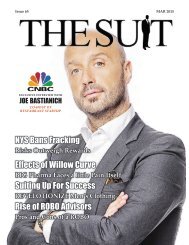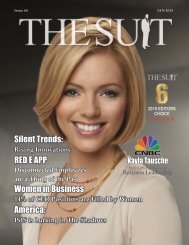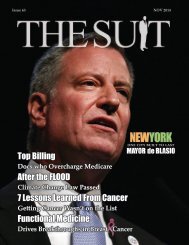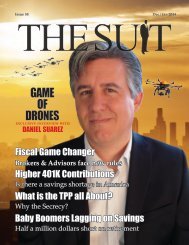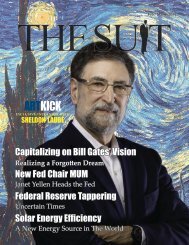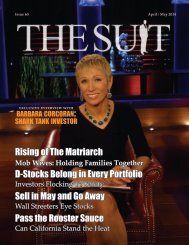o_19grqq7snim9mn019q11f7ds26a.pdf
Marcus Lemonis, a serial entrepreneur and host of the show “The Profit” on CNBC, is a true survivor in the corporate world. The native-born Lebanese business man endured the chaos of a civil war in Beirut and eventually moved to Miami. Lemonis was exposed to the automotive industry throughout his upbringing - his grandfather owning two of the largest Chevrolet dealerships in the United States and Lee Iacocca serving as the family friend and later mentor to Lemonis. On page 12, we conducted an interview with “Profit” host Marcus Lemonis, who offers struggling small businesses capital investment and his expertise in exchange for an ownership stake in the company. In the latter part of the magazine, we interviewed countless wealth advisors during these tough economic times. We recognize that some of the changes in 2013 and 2014 require relevance for financial planners. Therefore, the financial industry continues to push for more realistic standards and reforms.
Marcus Lemonis, a serial entrepreneur and host of the show “The Profit” on CNBC, is a true survivor in the corporate world. The native-born Lebanese business man endured the chaos of a civil war in Beirut and eventually moved to Miami. Lemonis was exposed to the automotive industry throughout his upbringing - his grandfather owning two of the largest Chevrolet dealerships in the United States and Lee Iacocca serving as the family friend and later mentor to Lemonis. On page 12, we conducted an interview with “Profit” host Marcus Lemonis, who offers struggling small businesses capital investment and his expertise in exchange for an ownership stake in the company. In the latter part of the magazine, we interviewed countless wealth advisors during these tough economic times. We recognize that some of the changes in 2013 and 2014 require relevance for financial planners. Therefore, the financial industry continues to push for more realistic standards and reforms.
You also want an ePaper? Increase the reach of your titles
YUMPU automatically turns print PDFs into web optimized ePapers that Google loves.
tion, even if that option has a lower<br />
expected return compared to alternatives,<br />
without violating the standard.<br />
A registered investment advisor<br />
MUST select the investment with the<br />
best expected return AND the least<br />
expensive cost. Generally RIA’s invest<br />
only in no or minimal cost investments<br />
and charge an overall advisory fee<br />
based on the size of assets under management<br />
– the more the assets grow,<br />
the larger the RIA’s fee. Client and advisor<br />
sit on the same side of the table.“<br />
In Edwards’ opinion, the broker-dealer<br />
business model is adversarial<br />
to the client’s best interest because<br />
the success of the BD is based on how<br />
much commission can be charged, not<br />
how well the client’s assets grow. In<br />
what Edwards calls the “daily battle”<br />
for client assets, ever more individual<br />
brokers are moving to registered investment<br />
advisory firms. This transition<br />
of tens of billions of client investment<br />
dollars constitutes an existential<br />
threat to traditional brokers and to<br />
FINRA, which is dependent on fees<br />
from brokers to fund its operations.<br />
Edwards doesn’t hesitate to say,<br />
“The whole discussion of the fiduciary<br />
standard is not to raise broker-dealers<br />
to the standard that RIAs currently<br />
work under, but instead to ‘dumb<br />
down’ the existing RIA fiduciary standard<br />
so that broker-dealers are less<br />
disadvantaged.”<br />
“What’s good for broker-dealers<br />
is not necessarily good for average<br />
Americans,” he emphasized.<br />
What Edwards does view as beneficial<br />
for American investors is a forward<br />
looking investment philosophy. Edwards<br />
tells his clients that comparing a<br />
portfolio’s rate of return to benchmark<br />
index returns is like referencing the tachometer<br />
in your car. “The tachometer<br />
tells you what the engine is doing,” he<br />
noted, “But if you focus only that one<br />
instrument, you will crash your car.<br />
A good driver must look through the<br />
windshield down the road, monitor<br />
what is coming next and be ready to<br />
make changes in anticipation.”<br />
Edwards tells his clients that there<br />
will be scenarios during which his investment<br />
strategy will under-perform<br />
the market. In 1999 he refused to buy<br />
Internet stocks even as the NASDAQ<br />
doubled that year. “I saw a huge bubble<br />
there and did not want to have<br />
anything to do with it,” he said. “My<br />
clients thought I was an idiot,” he said<br />
with humor in his voice, “until the<br />
following year when the NASDAQ<br />
crashed 80 percent.” Edwards was<br />
perfectly happy to buy Amazon, Cisco,<br />
and EBay in 2002 because the risk/<br />
reward ratio had tilted dramatically in<br />
his favor.<br />
Edwards believes his job to show<br />
his clients how they can realistically<br />
achieve their financial dreams - an early<br />
retirement, a second home, funding<br />
a grandchild’s medical school tuition.<br />
Edwards will take on just enough risk<br />
to achieve those dreams, but no more.<br />
He is a practitioner of “Purpose Based<br />
Asset Allocation,” which is a process of<br />
segregating a client’s assets into multiple<br />
accounts with different strategies<br />
for short, medium and long term needs.<br />
For example, if a client needs funds in<br />
a month or so for a tax payment, tuition<br />
payment or house closing, Edwards<br />
will invest those funds only in<br />
non-volatile assets like money markets<br />
and treasury bills. For long term needs<br />
such as retirement where the horizon is<br />
5-20 years in the future, Edwards will<br />
choose volatile but higher returning<br />
assets like US and international stocks,<br />
and commodities.<br />
“Risk is not volatility – the amount<br />
that a particular asset will rise or fall on<br />
a given day,” says Edwards. “Risk is<br />
the chance money won’t be there when<br />
you need it. We can’t take any investment<br />
risk for cash payments need in<br />
the next 30-90 days, and we invest very<br />
conservatively for cash flows due in the<br />
next 3-12 months. Funds set aside for<br />
retirement MUST be invested aggressively<br />
when the client is younger to<br />
achieve the higher returns derived from<br />
more volatile securities. As the client<br />
approaches retirement, we will systematically<br />
increase the fixed income component<br />
of the portfolio – lower overall<br />
return, but less volatility.” Edwards<br />
closed by commenting, “During the financial<br />
crisis of 2008-9, there was never<br />
a moment where we had to reduce the<br />
monthly draw of our retired clients –<br />
mission accomplished!”<br />
670 West End Avenue 14th Floor<br />
New York, NY 10025<br />
Toll-free (800) 994-3766<br />
Local (347) 580-5280<br />
www.HeronFinancialGroup.com<br />
THE SUIT MAGAZINE p.65




